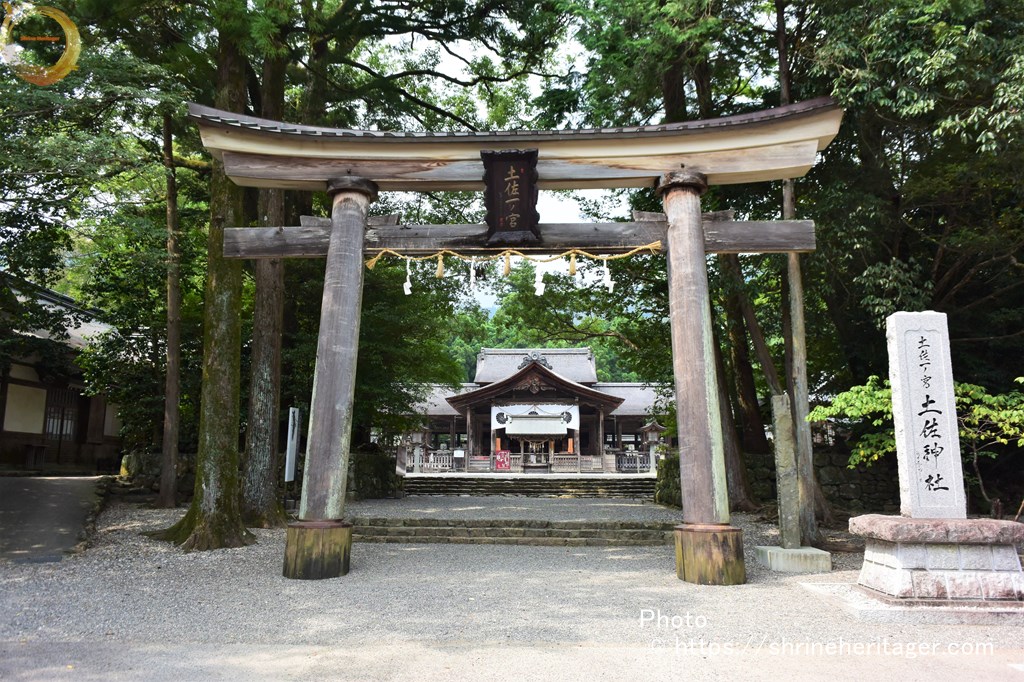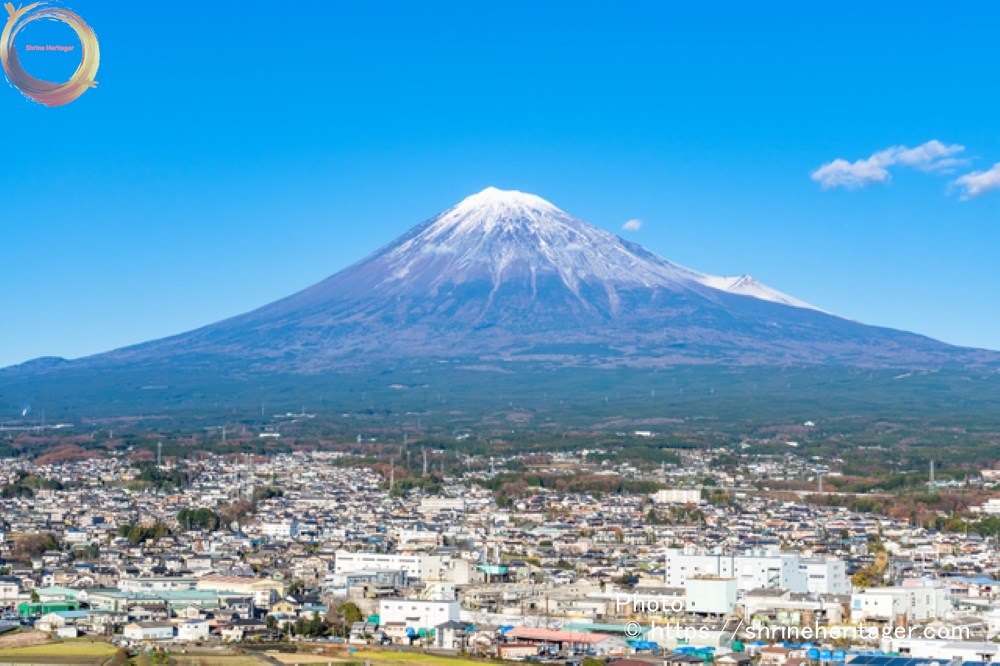Tosa Shrine (Shinane-sama) has a high formality as a shrine in Tosa Province Since ancient times, it is said that this stone called "iwakura", a natural stone where God dwells, was built and enshrined in a place where it fell here and stopped, and the creation dates back to ancient times.
目次
- 1 1.Introduction (Introduction)
- 2 Preliminary knowledge of this shrine (Preliminary Knowledge of This Shrine)
- 3 Visit the Shrine (Pray at the Shrine)
- 4 Old tales held down to shrinks
- 4.1 On the Tradition written in Nihon Shoki Emperor Tenmu Article 4 (675) March 2 Article 13 of August 13, 686
- 4.2 "Tsuku Nihongi" (764)
- 4.3 The Legend of "The God of The Festival" written in "Shaku Nihongi" Vol. 15 "Tosa Kuni Fudoki"
- 4.4 "Shaku Nihonki" Vol. 12 On the Tradition of the One Word Lord God Article
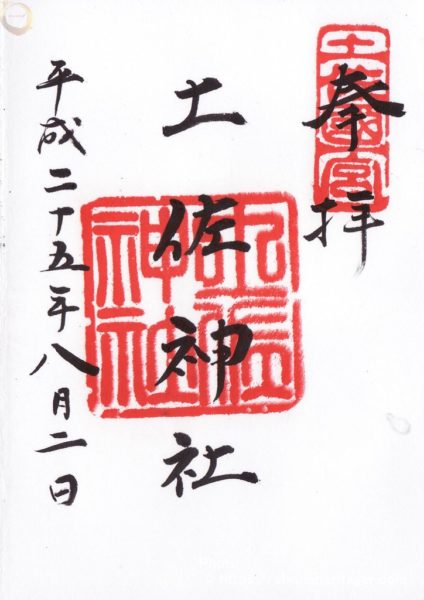
1.Introduction (Introduction)
The official name of this shrine and how to be called The present address and map I will introduce the history of the god and the shrine enshrined.
[Shrine name]
Tosa Shrine (Tosa
Shrine)(とさじんじゃ)
[Common name]
Shinane sama
[Location]
2-16-1 Ichinomiya Gane, Kochi, Kochi Prefecture
[Google Map]
[God's name to pray]
"Lord" Ajisuki Takahikone-jin (ajisuki takahikone no kami)
"Lord" One Word Lord (Hitokotonushi no Kami)
[God's Great power]
Victory prayer Victory prayer Victory prayer
Setsubun Festival Setsubun Festival
Shichigosan 7 year old 5 year old 3 year old celebration
New Year's visit Baby prays at shrine for the first time
Home safety Safe and stable home life
Business prosperity Wishing business prosperity
Traffic safety Prayer for Traffic safety
Academic achievement Want to acquire knowledge and skills
Prayer at an age contained a
lesson in life Avoid bad directions
Personal safety Body and life safety
Disease healing God ceach the disease
Ansan Healthy childirth
It is said that Ajizo Takahikone is the son of the Great Power Lord God, and it is said that he is a god of prosperity in all industries such as the development of the country, agriculture, industry, and commerce, and one word lord god is a god with a special faith that things are solved in one word as a god of unity cooperation.
As a result, our company has long been revered as a general guardian of the Nankai, as a god of home safety, agricultural prosperity, construction, politics, etc., and it is honored as a god of navigation safety, traffic safety, and healing of disease by his achievements.
From the official website
[Rules of dignity]
"Engishiki Jimmeicho"
Tosa Kuni
Ichinomiya ・ Betsute Shrine
[Beginning of history]

It is not clear about the restoration of Tosa Shrine, but it is thought that the natural stone called the gravel stone in the northeast part of the precincts was enshrined as a enshrined shrine, and it is said to date back to ancient times.
During the Heian period, when the system of Enki was declared, Emperor Daigo's reign was lined up by Shikiuchi Taisha shrine and called Tosaza Shrine, and there were often visits of the imperial family's reverence envoy, and in 940, the Shinto floor was advanced to the throne.
At the beginning of the Kamakura period, it entered the Shinto-Buddhist custom era and was designated as tosa kunisangyou ichinomiya. The Ichinomiya Shrine was formed at our company, Jinguji Temple, and Zenrakuji Temple, and was called Tosa Takagamo Daimeijin.
In the Muromachi period, in 1570, The Emperor Masachika's former head of turtles (1570), the former parents of Nagasogabe revived the main shrine, the mint hall, and the worship hall, and the Emperor Godai Keichoroku (1 In 1601), he enjoyed Yamauchi Ichitoyo-soi and licensed the former company territory, and in the second generation Tadayoshi, he added torii, a tower gate, and a drum tower, and made it the best prayer center in Tosa.
In the first year of the Meiji era, the year-ended Shinto-Buddhist custom era, which lasted for many years, was renamed Tosa Shrine in 1868, and the name was lined up in the National Mint Nakasha.
After the war, the government mint system was abolished in 1946, and it is now considered to be the annex shrine of the shrine's main office.From the official website
[History]
Tosa Shrine Visits
The festival is celebrated with the god of Tosa, Tosa Takakamo Taisha, Takakamo Daimyojin, etc.
According to the Japanese secretary, the founding age is said to be far away and the upper ancient era.In particular, there are often visits of the imperial family, and in the Heian period, emperor Suzaku's reign, Tenkei 3rd year (century 940), the shinto floor was advanced to the first place,
As a shrine of Tosa's national general guard, at that time, the reverence of Takemon was thick.
During the Muromachi period, in the first year of the year of the Emperor Masachika-cho and Gengame (Century 1570), former parents of Nagasogabe revived the main shrine, the mint hall, and the worship hall.
During the Azuchi-Momoyama period, in the 6th year of The Emperor Go-Yosei(Century 1601), he enjoyed the seal and licensed the former company territory, and he built a torii, sakuramon, and drum cherry blossoms to the country of Tosa.During the Heian period, when the system of enki was declared, emperor Go-Daigo's reign (901-923 centuries) was lined up at Taisha Shrine.
In 1871, the shrine was called Tosa Shrine.
After the war, in 1946, the long-lasting shrine system came to an end and became a religious corporation.From "National Shrine Festival Comprehensive Survey (1995)" [Shrine Main Office]
[Other decisions within the preciss]
From the left towards the Sansha-den
On the left side, the shrine "Lord"
Chuo Nishigozensha "Lord" Festival God Unknown
On the right side of the Great Power Shrine "Lord" Great Power Lord God
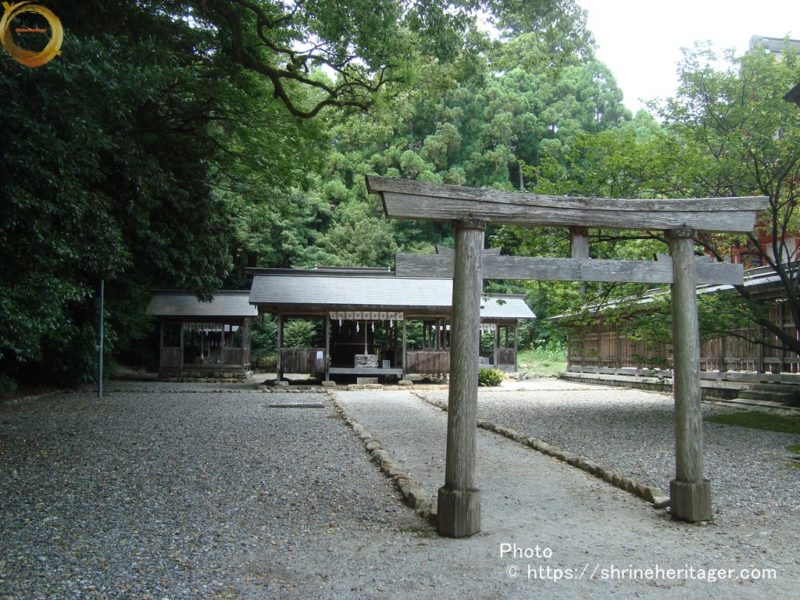
Gravel stone (tubute ishi)
The stone which threw it when the seat of the old god is decided is here, and it is enshrined thickly.
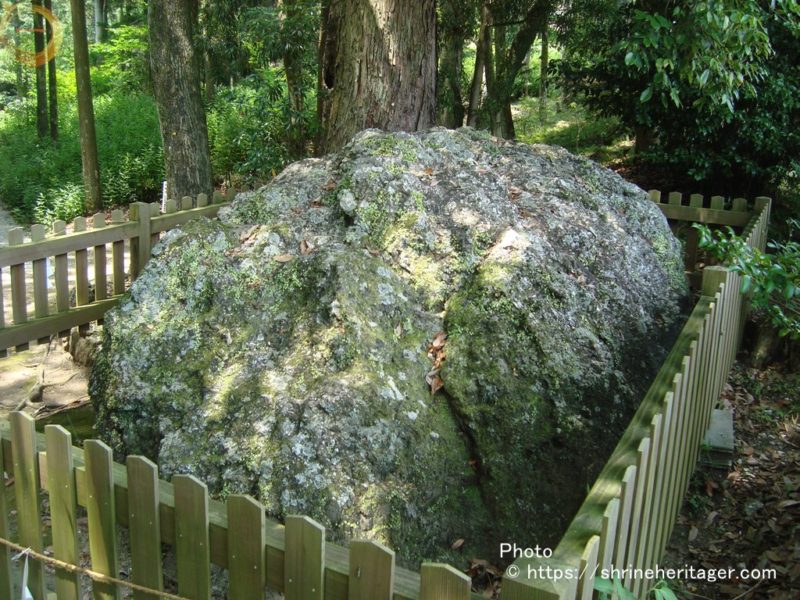
Shinmei-gu "Lord" Ise Ryogu
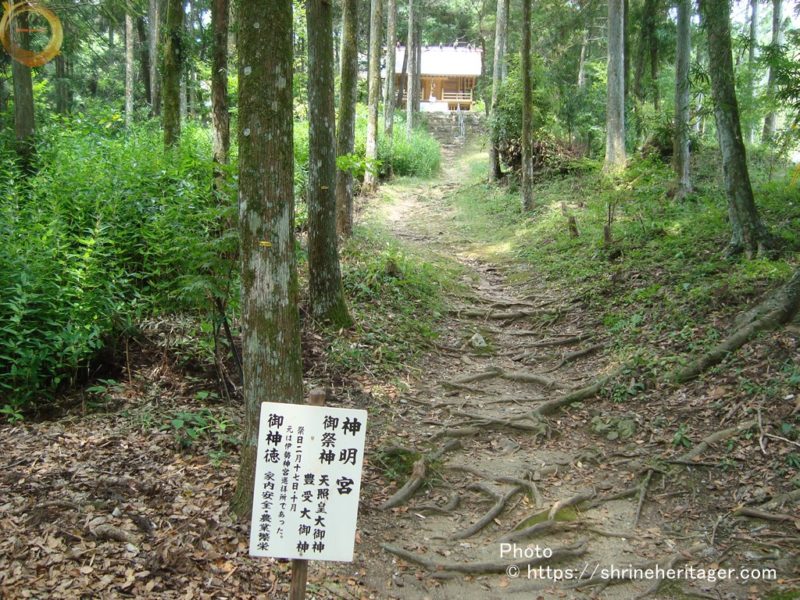
Itsukushima Shrine "Lord" Ichikijima Himemei
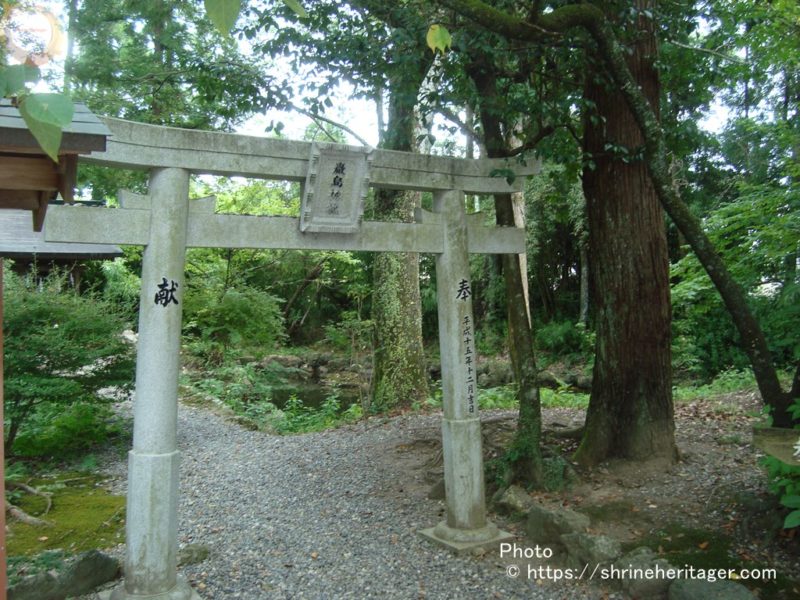
Takinomiya Shrine "Lord" Festival God unknown
Toten Shrine "Lord" Festival God unknown
Nishiten Shrine "Lord" Festival God unknown
Harumiya Shrine "Lord" Festival God unknown
スポンサーリンク
Preliminary knowledge of this shrine (Preliminary Knowledge of This Shrine)
This shrine has a long history.
"Engishiki Jimmeicho"(compiled in December 1927) 2 volumes that are important among all 50 volumes of rule-of-law scrolls created by the Imperial Court in the middle of the Heian period The contents are listed in the list of government companies (Shikinaisha) nationwide about 1100 years ago, and the name of "2861 companies" and the number of gods who sit there Tenjin ji-gion -> "3132 seats" are listed.
[Enki-shiki Shinmeisho] (engishiki jimmeicho) The shrine record was completed in December 927 AD.
[Old Administrative Division] (Old administrator district)
(God's seating number) Nankai-do 163 seats... Large 29
(including 10 of which are deposited monthly Shinjo, and 4 of which are deposited), small 134
[old country name] (old country name)
Tosa Kuni 21 (large 1 seat, small 20 seats)
[old county name] (old region name)
(Number of seats of God) Tosa-gun 5 seats (large 1 seat, small 4 seats)
[Meishin University Small] Shikiuchi Taisha
[Old shrine name] Tosaza Shrine (Large)
[Furi-1] (Tosi-no-Kami no Yashiro)
[How to read](tosani imasu kamino yashiro)
https://www.digital.archives.go.jp/DAS/meta/listPhoto?LANG=default&BID=F1000000000000004146&ID=M2014101719562090086&TYPE=&NO= Image Use
National Diet Library Digital Collection Enki-shiki Publication (Published) [Former Kuraya] Autumn Leaves Mountain Library
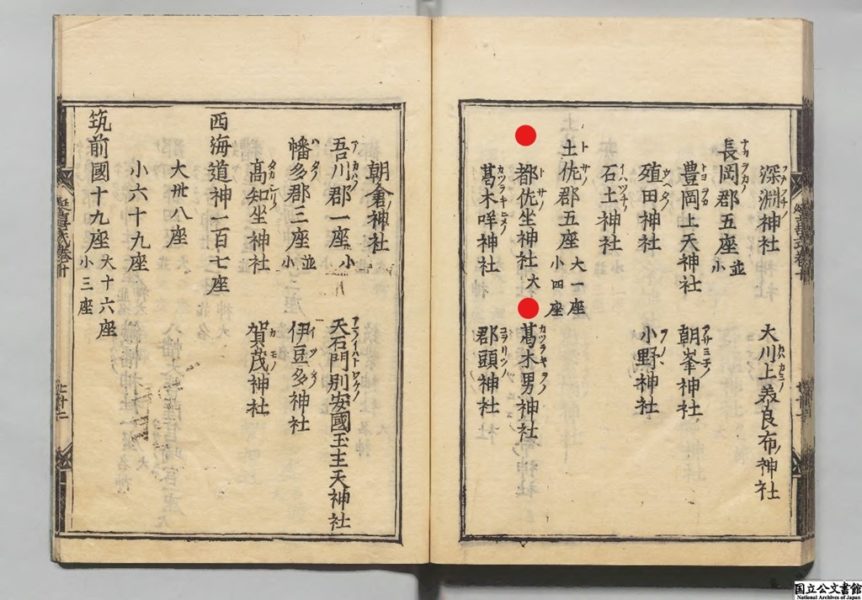
[Otaky Point] (Points Selected by Japan Otaku)
I will introduce the preliminary knowledge that you will be interested in this shrine from a otaku's point of view.
"Ajisuki takahikone no kami" of the festival god and
About "hitokoto nushi no kami"
On August 13, 686, 686, there is a strong reverence from the Imperial Court, such as praying for the healing of Emperor Tenmu's illness.
"Tosa Kuni Fudoki"
"The name of god is not "one word lord's son", and the father is not understood well, but in a certain legend, it is said that it is "Ajislow Takahikon son" the son of the great power lord.'
The god of the festival is "a word of master's son" and "Ajislow Takahikon-son"
These two pillars of the deity are gods who have been enshrined as the clan gods of Yamato Katsuragi by Mr. Kamo since ancient years.
It is said that it was enshrined here because mr. Kamo of Yamato or his family was entrusted to the national construction of Tosa.
tsubute ishi
Ogami, who arrived at "Kamonochi" in Tosa, stayed in the land of present-day Tosa Shrine and was enshrined as a "gravel isi"
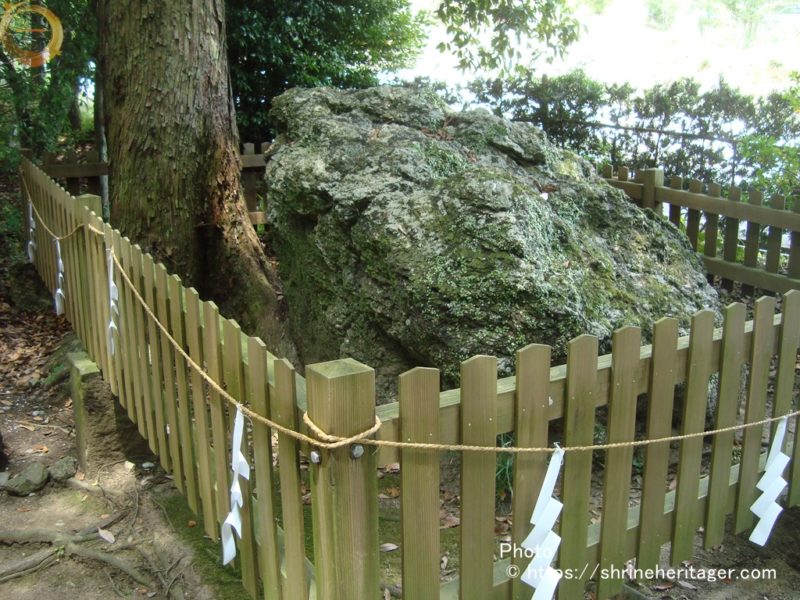
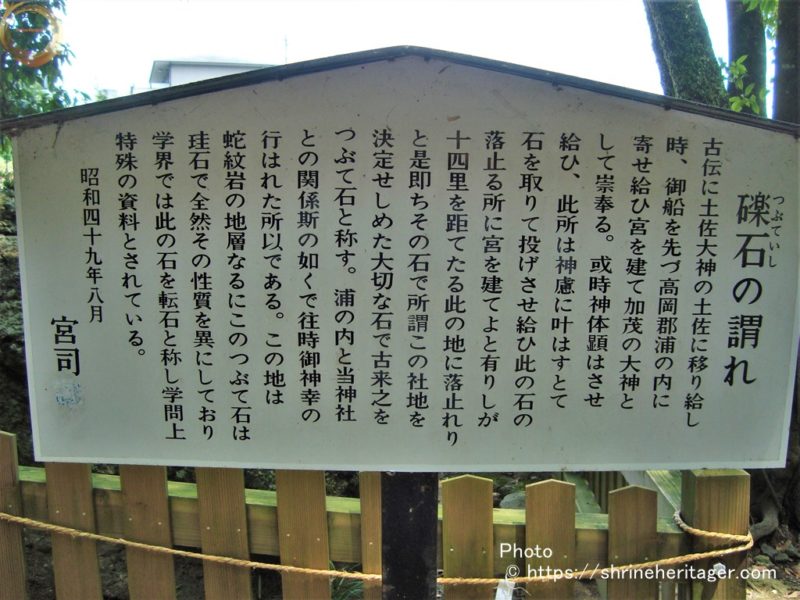
The Sore of the Gravel Stone
When he moved to Tosa of Tosa Ogami in the old story, he sent the ship to Takaoka-gun Ura ahead, built a salary shrine, and worshiped it as the great god of Kamo.
At one time, the god body manifestation is made to grant to the shinto thought, and it is made to throw it by taking the stone, and it throws it, and the shrine is stopped in the place where the stone of the salary is stopped, and, i.e., the stone is decided, and it is called an ancient person with an important stone which decided this site so-called by the stone.
It is the reason why the line of the god happiness in the past was done like such a leap clerk between Uranouchi and this shrine.
This ground becomes the formation of the serpentinite, and this crushed stone is a silica stone, and the nature is completely different, and this stone is called the rolling stone in the academia, and it is considered a special material academically.
August 1974 MiyajiFrom the precincts guide board
It is written here, and it is a koto of the present "Naruno Shrine (Uranonai Naruno, Susaki City, Kochi Prefecture)" that is said to be "to build a shrine in Takaoka-gunura and worship it as a god of Kamo"
Please see the article of Narunashi Shrine which is said to be the motomiya (former jinzachi) of Tosa Shrine.
Shinko Matsuri (Mikoshi Togo) August 25 Th Thye Thonging Festival (August 24th and 25th)
Kamiyuki Matsuri (Mikoshi Togo) August 25th is a festival of the deceased between Tosa Shrine and Narunashi Shrine.
On the afternoon of the 25th, a boat with a big fishing flag floated in Urano shrine and a brave Kamiyuki (boating) will be held at Naruno Shrine.
God happiness begins at 3 p.m.
In ancient times, it was called the boating of god, and it was stopped because of the sea accident though it went to Naruno Shrine (Uranouchi east part of Suzaki city) of Uranouchi Bay in Suzaki City,In the Edo period, a travel station called Koichinomiya was established on the north shore of Godaiyama, Kochi City, and Funato was held.
In addition, since the fact that the travel center was built in our southern ipponmatsu in 1868, God's day has been carried out on foot.
From the official website
スポンサーリンク
Visit the Shrine (Pray at the Shrine)
I introduce the state when I visited this shrine.
From Tosa Ichinomiya Station, take Prefectural Road No. 251 north, about 1.5km by car for about 8 minutes.
At the entrance of the approach, there is a gate (Shinkomon Gate) built.
It is said that the construction of Tadayoshi Yamauchi, the second lord of the second feudal lord (national important cultural property) in 1631.
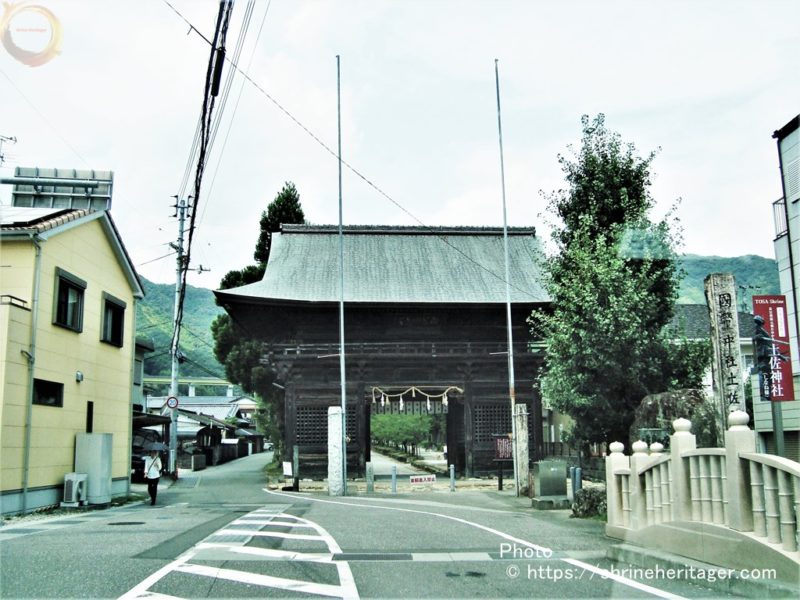
From The Shinkomon gate to the precincts in the direction of just north, a straight approach extends about 300m.
Arrived at Tosa Shrine (Tosa Shrine)
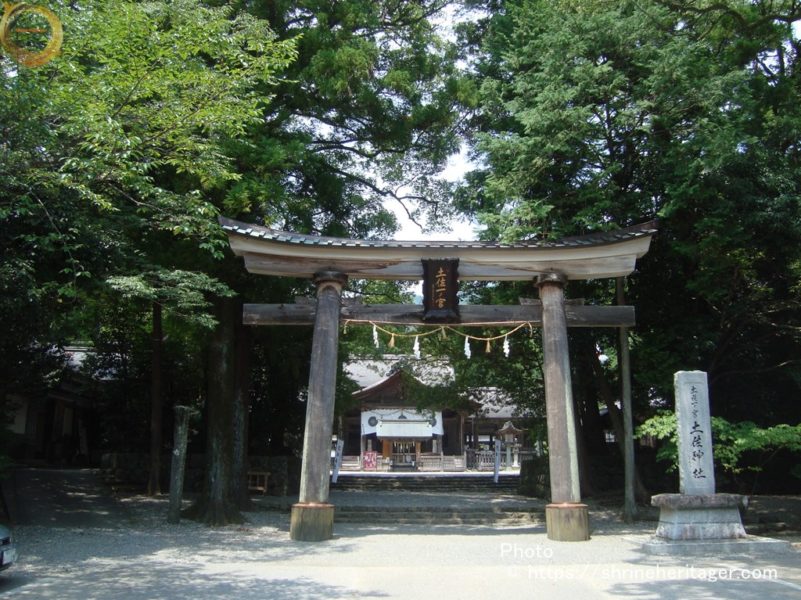
There is a temizusha on the left side in front of the entrance of the precincts, and the water mouth is cleansed from the dragon god.
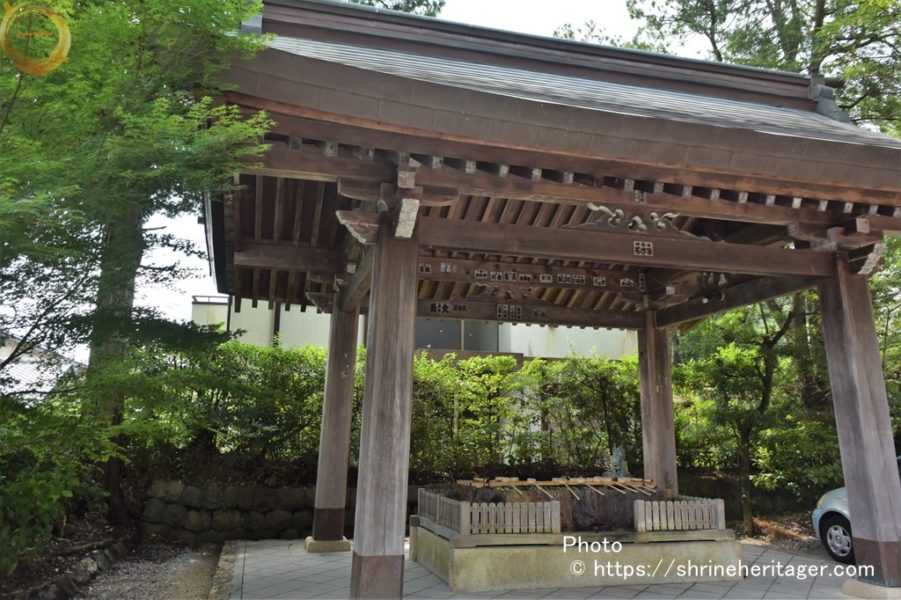
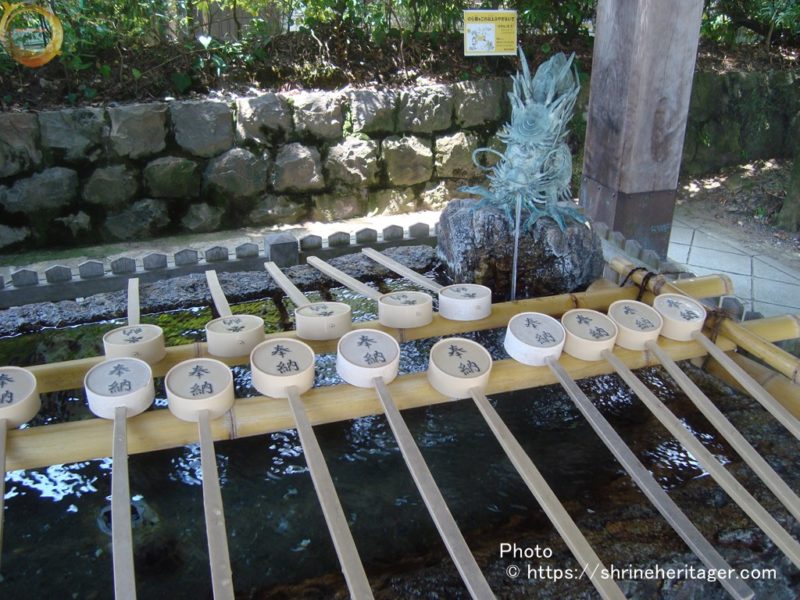
A wooden torii gate is built at the entrance of the shrine.
There is "Tosa Ichinomiya" on the forehead, and the company's name mark "Tosa Ichinomiya Tosa Shrine" is built side by side.
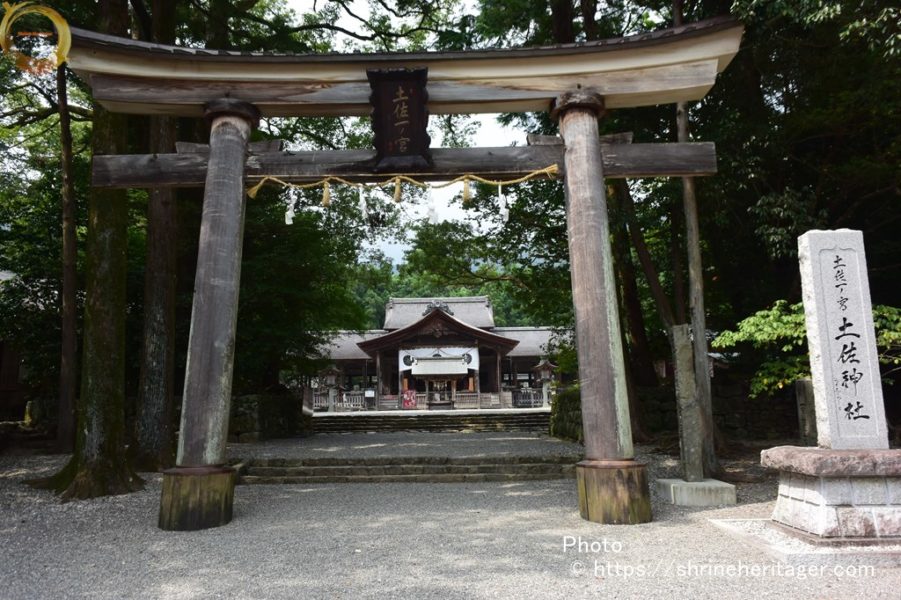
The lords of generations are revered against Tosa Shrine, and the present shrine building has a guide board with the re-construction operation by former Lord Nagasogabe.
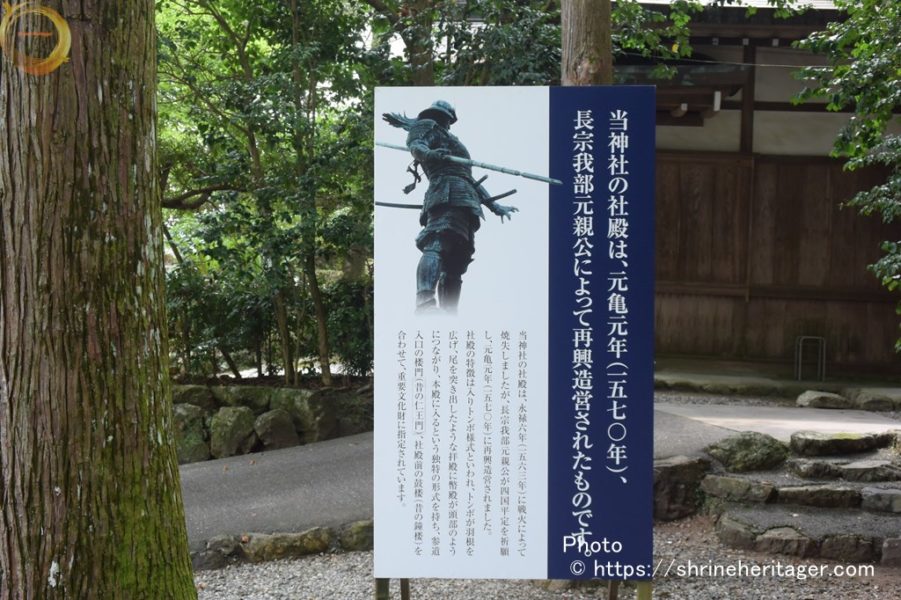
To the right of the precincts is the drum tower, and ema-den is on the left.
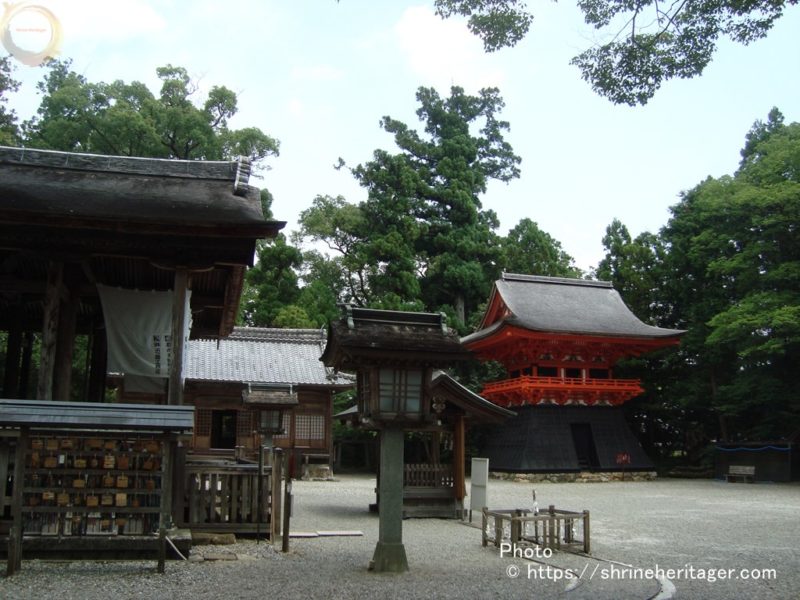
The drum tower is said to have been built in 1649 by Tadayoshi Yamauchi, the second lord of the domain(1649).
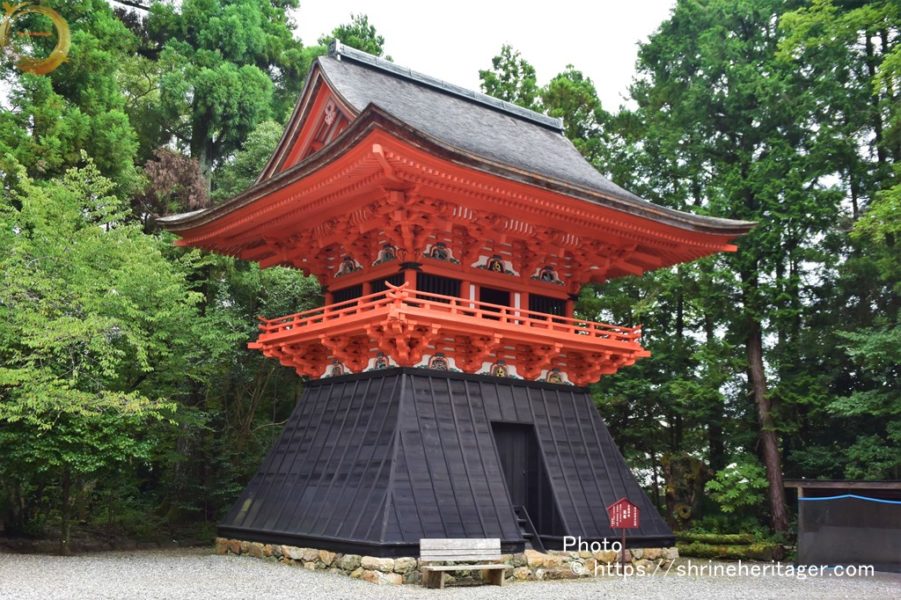
There is a shrine in front of the shrine.
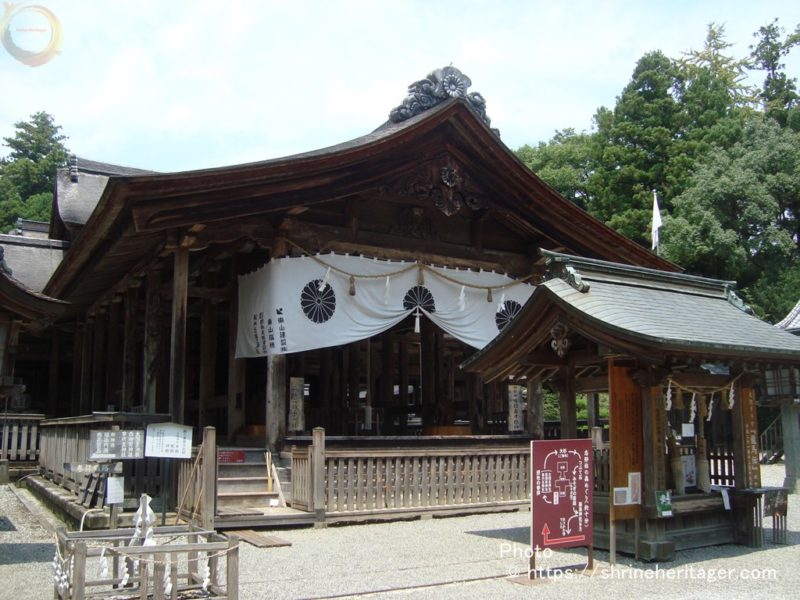
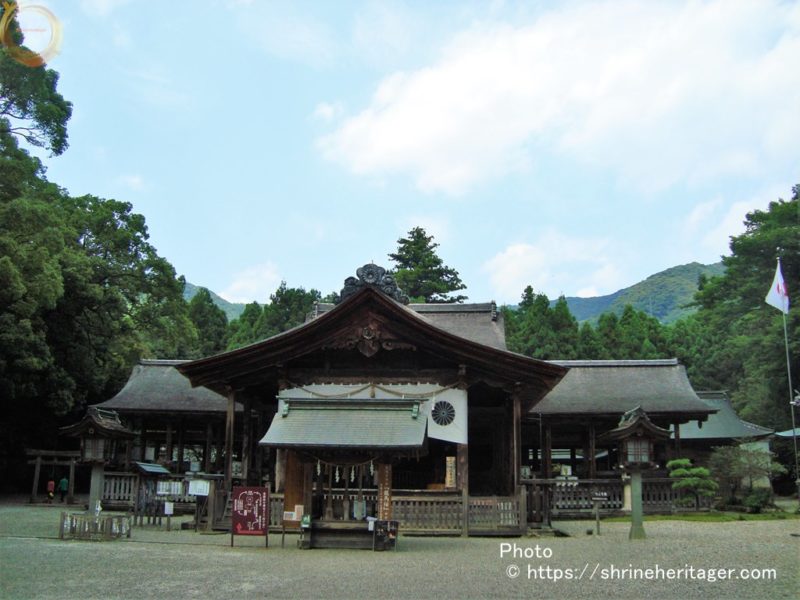
The shrine hall is set up a left and right wing worship hall, and the coming of worship is approaching in front of it.
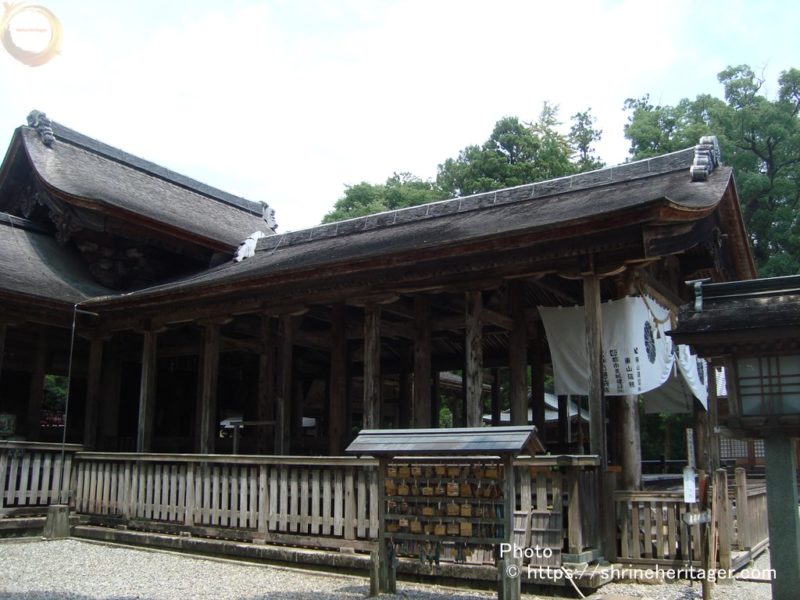
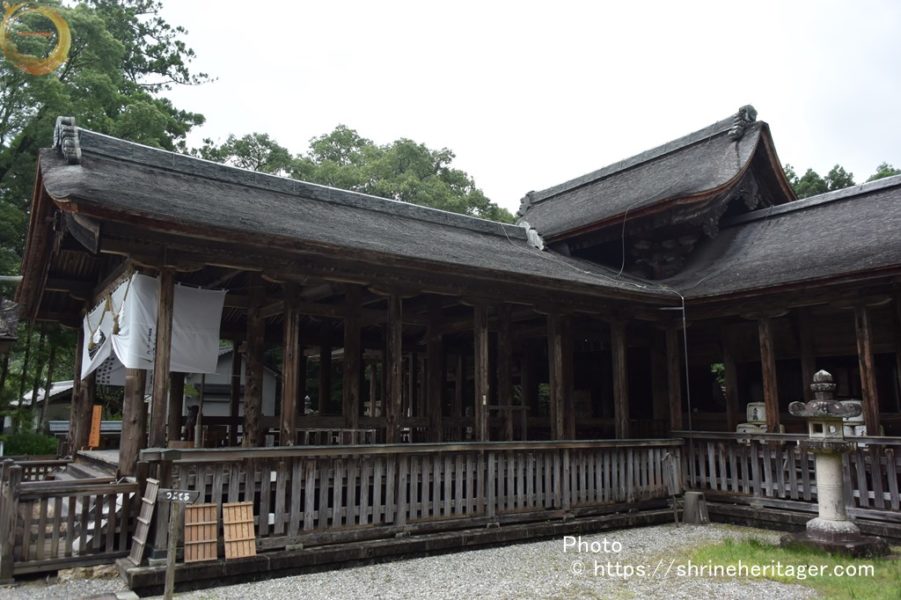
It is a shrine hall of
a rare architectural style called iri-no-dragonfly. It is just "dragonfly shape (like a cross)" is a rare building shrine (national important cultural property)
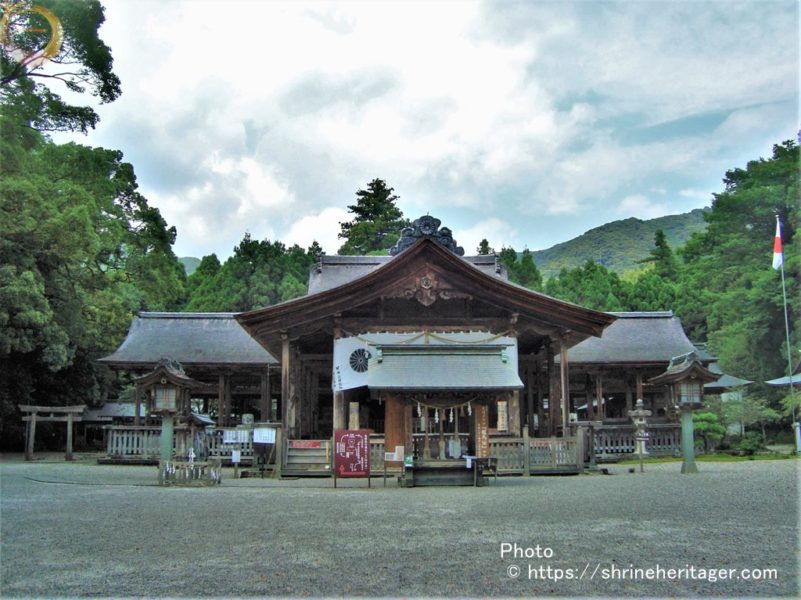
I'm going
to go to the shrine. I'm sing a
lot of money. I wish you all the best. I pray with my hands together, hitting a high hand that can't reach the god of worship who bows and settles while wishing to be in accordance with your divine power.
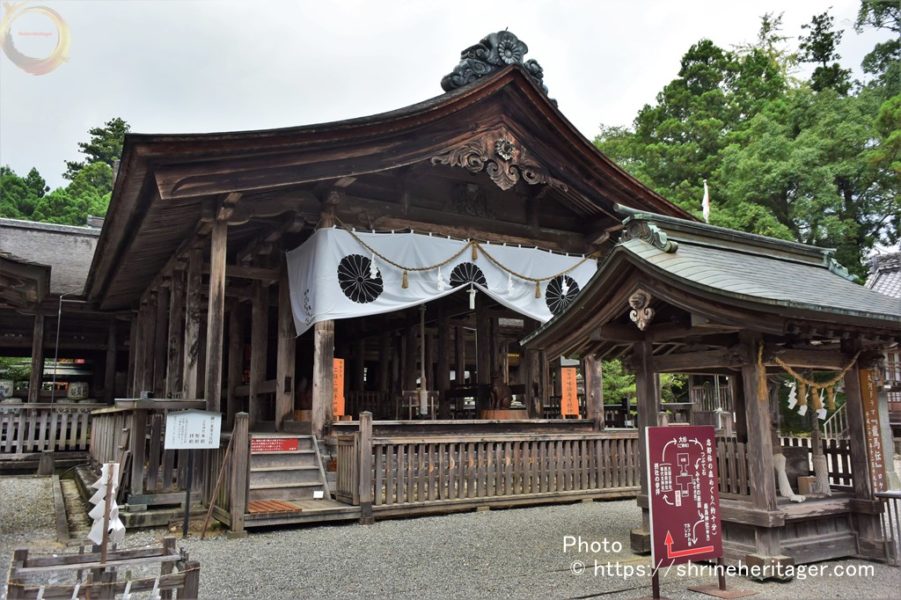

Right-wing worship hall towards
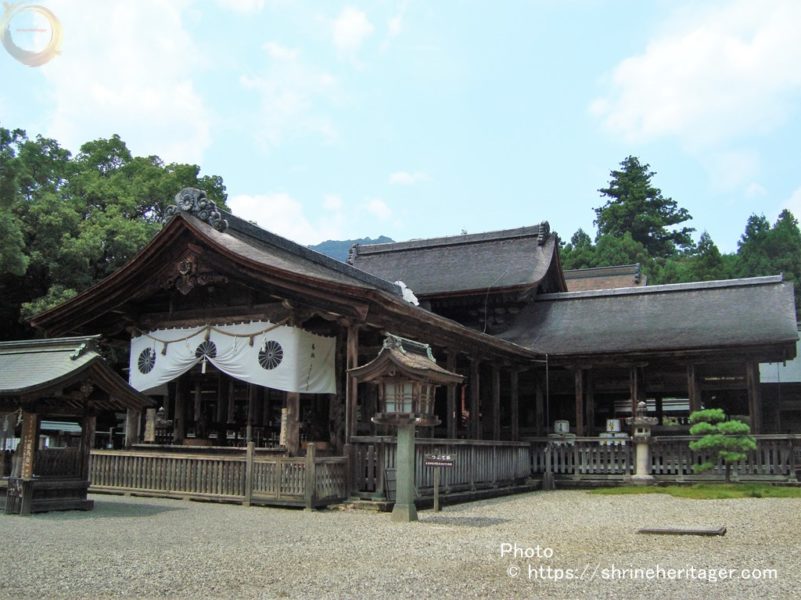
Left-wing worship hall towards
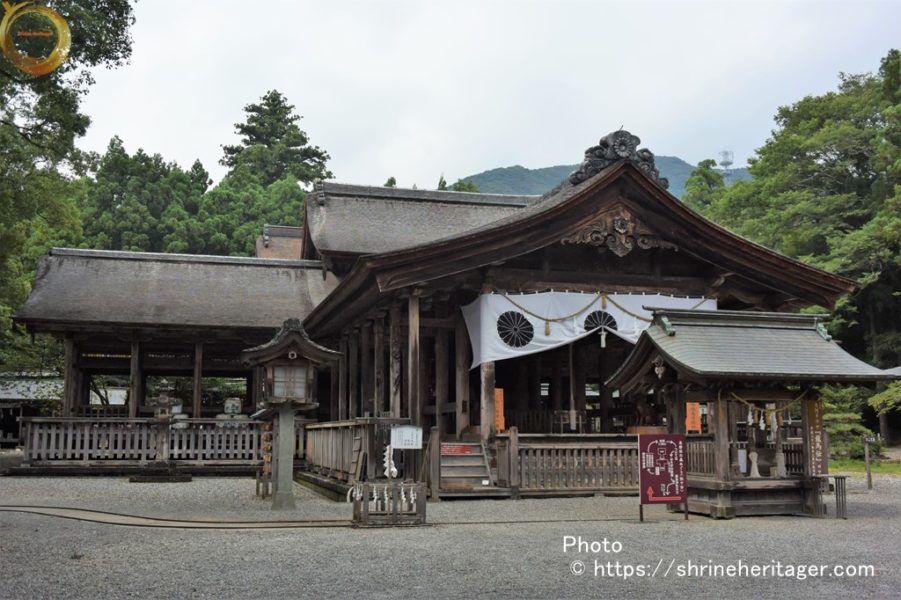
Main Hall (Kunishigebun)
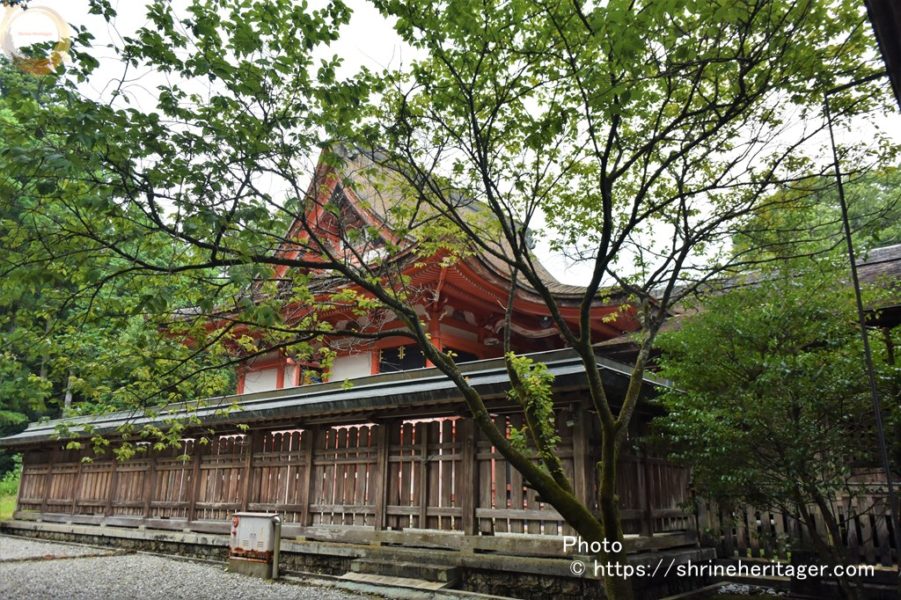
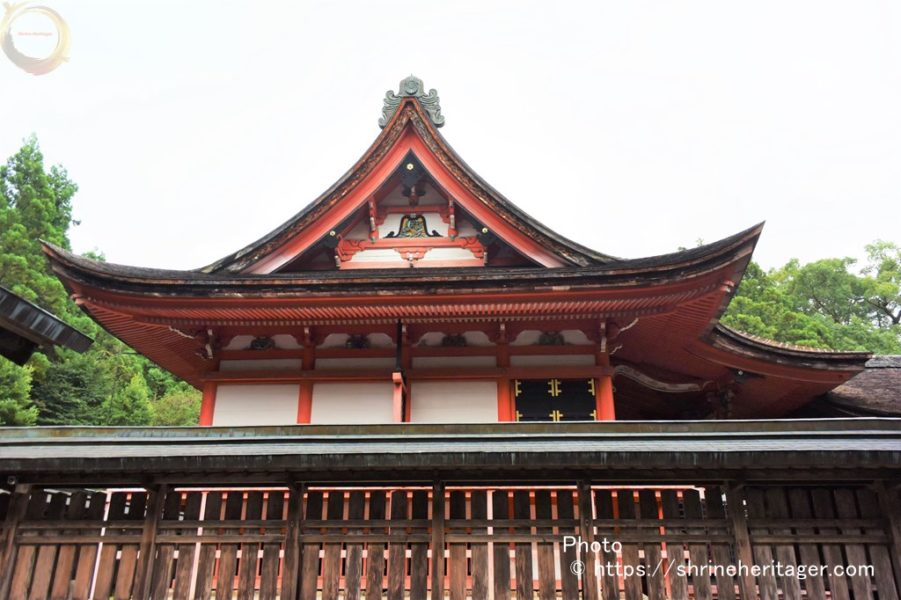
There is a guide board of "Shinae no Mori Tour" and worships as it is.

From the left towards the Three Shrines

On the left side, the shrine "Lord"

Chuo Nishigozensha "Lord" Festival God Unknown
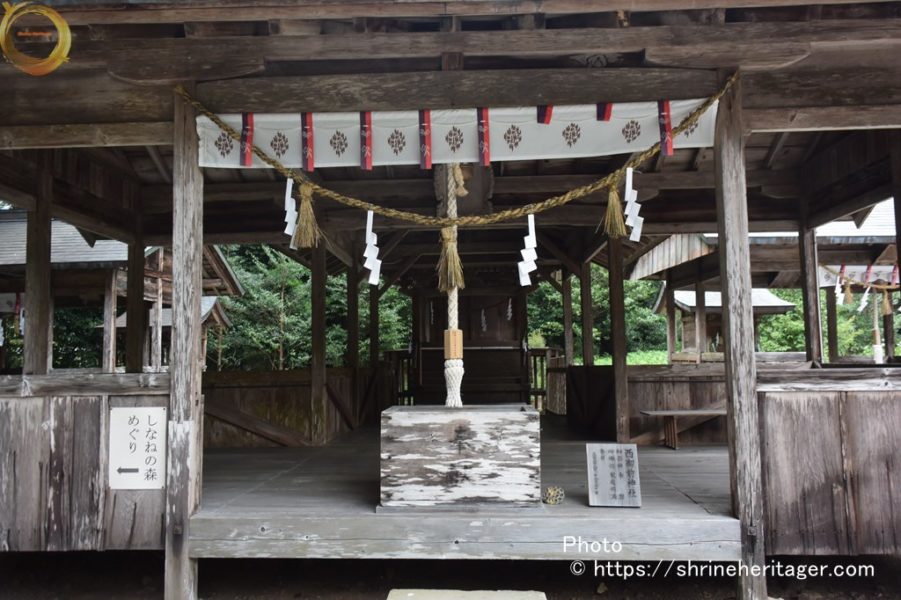
On the right side of the Great Power Shrine "Lord" Great Power Lord God
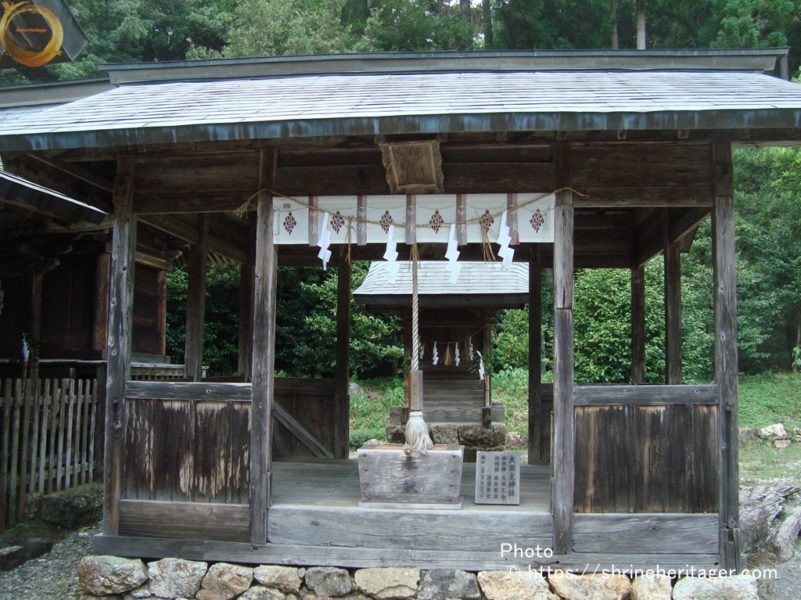
The spring water flowing into the forest of Shinaei becomes a stream, crossing a small shinbashi bridge over here.

There is a large cedar of the sacred tree, and a stone shrine sits behind it.
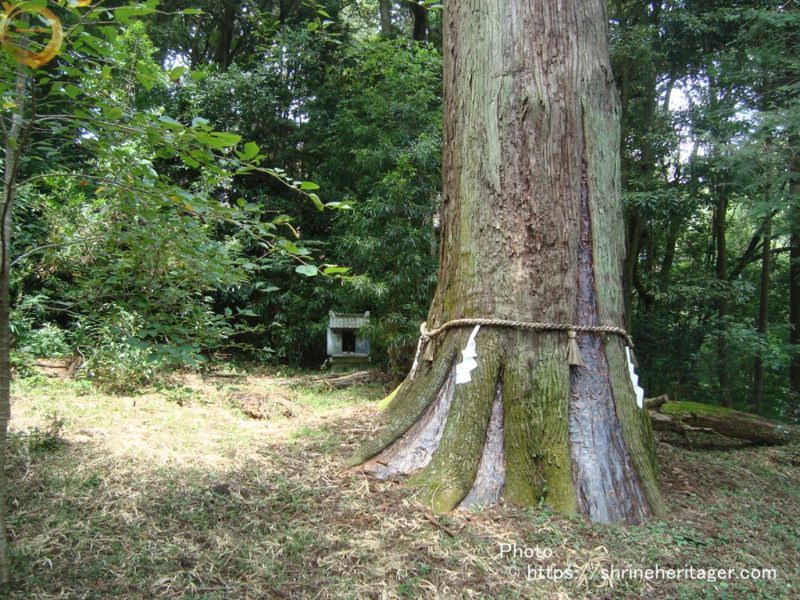
We're going to get to the tsubte is enshrined as a stone 籬 god.
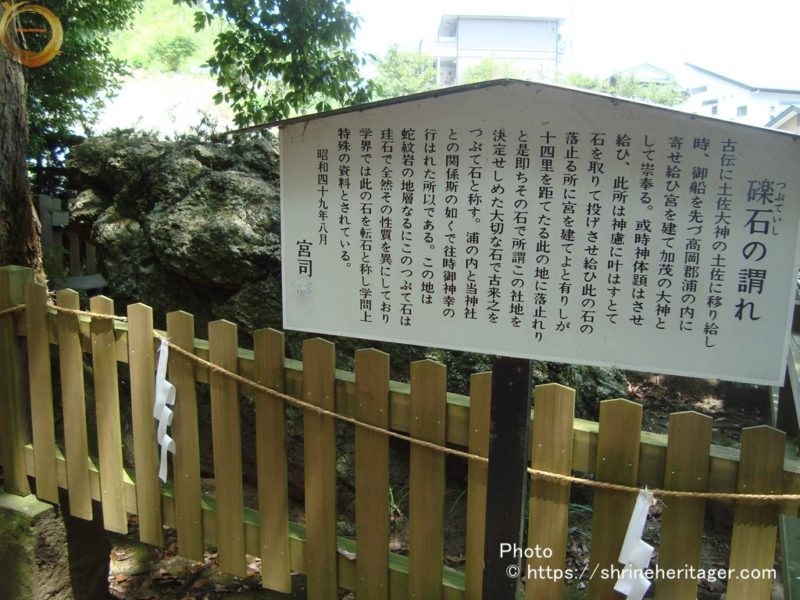
There's a narrow approach to the stone from the tip of the stone.
Shinmei-gu "Lord" I visit Ise Ryogu Shrine
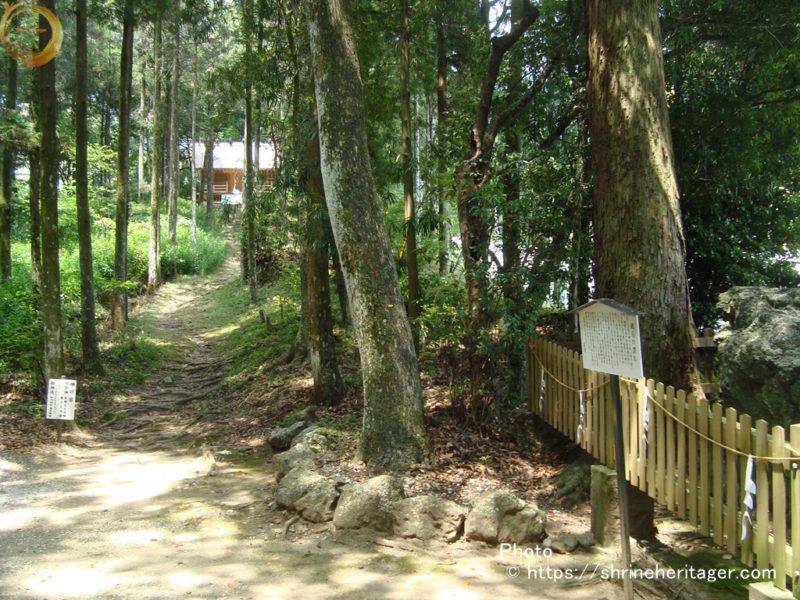
There is a ring-pulling exorcism, and it passes through the stump of the large tree of the cedar which was a sacred tree before in the manner of the circle of the great exorcism.
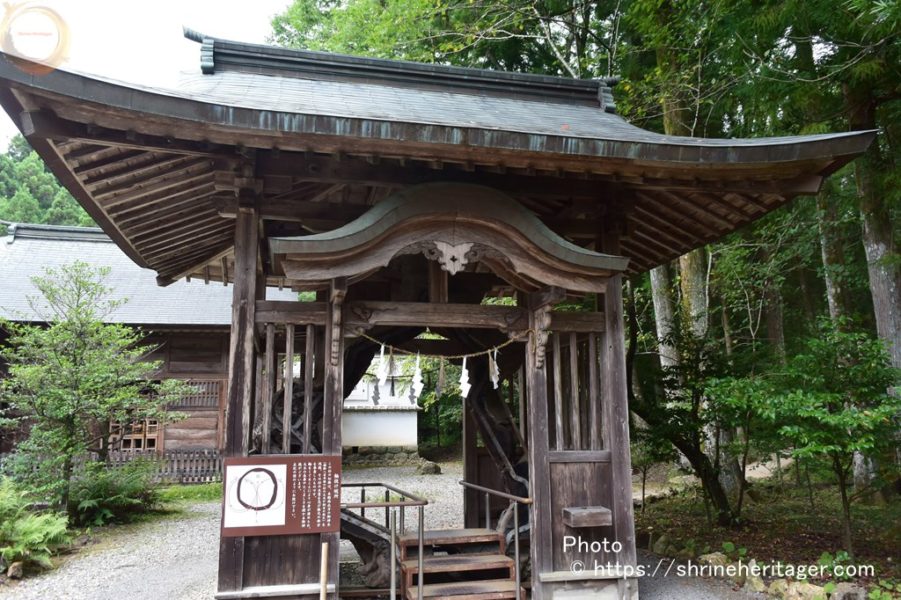
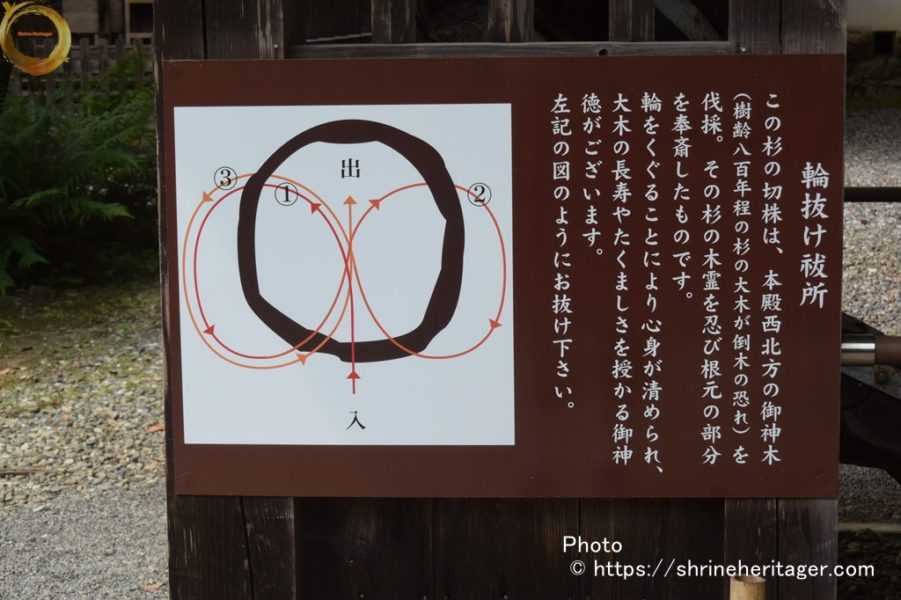
float in a pond
Itsukushima Shrine "Lord" I visit Ichikijima Himemei
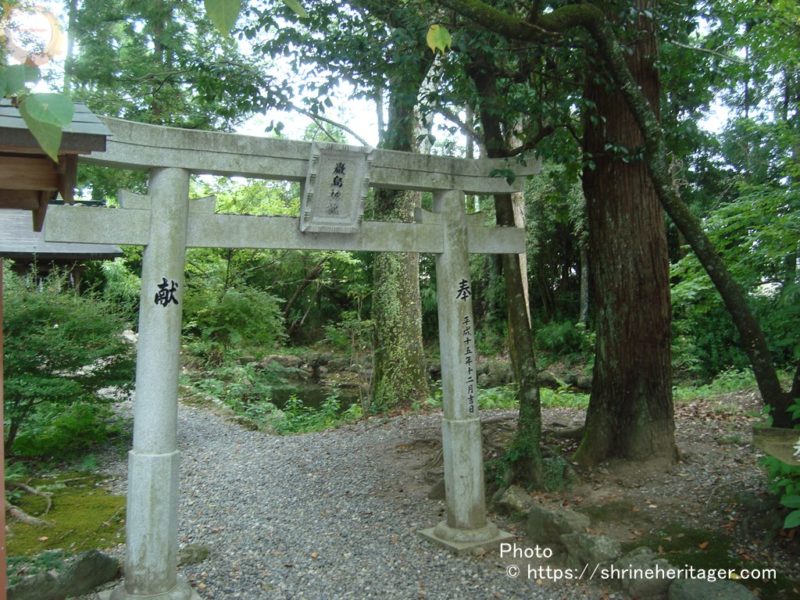
You will receive a charm and a seal at the awarding office on the west side of the entrance of the precincts.
I'll leave the precincts.
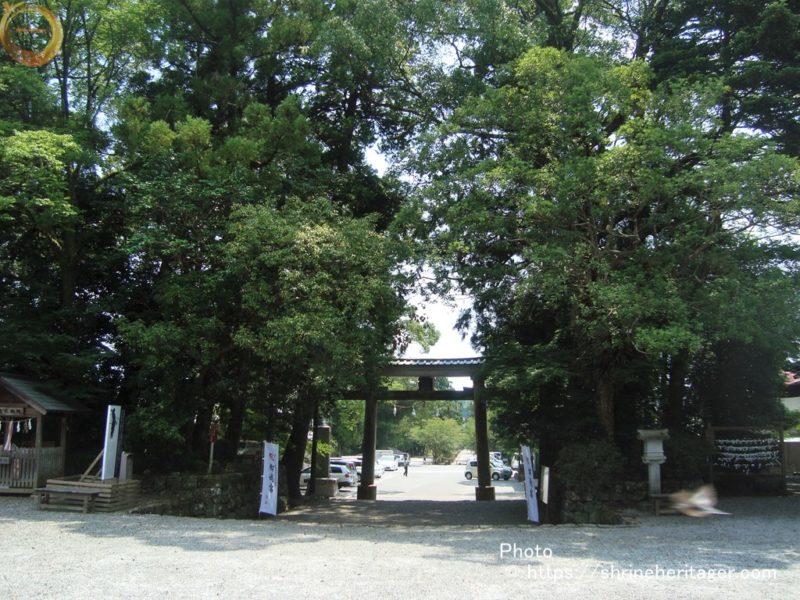
Go through the torii gate, look back, bow
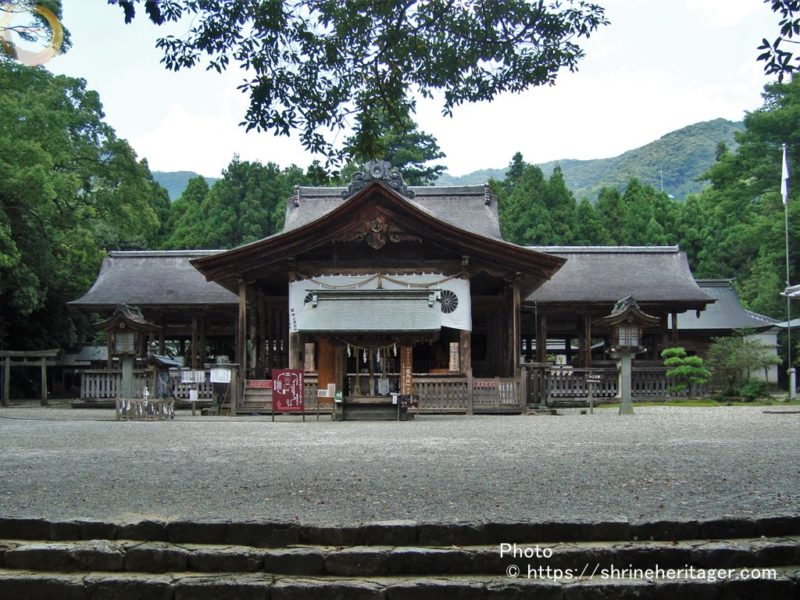
スポンサーリンク
Old tales held down to shrinks
I introduce the thing related to this shrine and the literature described.
On the Tradition written in Nihon Shoki
Emperor Tenmu Article 4 (675) March 2
Article 13 of August 13, 686
It is described with the title of "Ohokami" as "Tosa no ohkomi" as the legend of the ancients, and it is a local god, but a deep reverence from the imperial court can be seen, such as praying for the healing of the emperor's illness.
Nordhaven
Emperor Tenmu article 4 (675) March 2
March 2: Tosa no ohkami presented a bite of god sword to the Emperor."
Article 13 of August 13, 686
August 9 I prayed to the gods for the emperor's indigres.
August 13: We sent hata no imiki iwakatsu to dedicate the mint (mint miura) to Tosa Ogami.
On this day, the Crown Prince added 400 seals to Prince Kusabe, Prince Otsu, and Prince Takaichi, respectively.
We added 100 houses each to Prince Kawashima and Prince Ninkabe."
[Reference]"Nihon Shoki" Publication Book Fumimasa 13-year winner, Prince Shamoto [former
brewer] Ministry of the Interior National Archives Digital Archive https://www.digital.archives.go.jp/DAS/meta/listPhoto?LANG=default> amp;BID=F10000000000047528&ID=M2017042515415226619&TYPE=&NO=Image Utilization
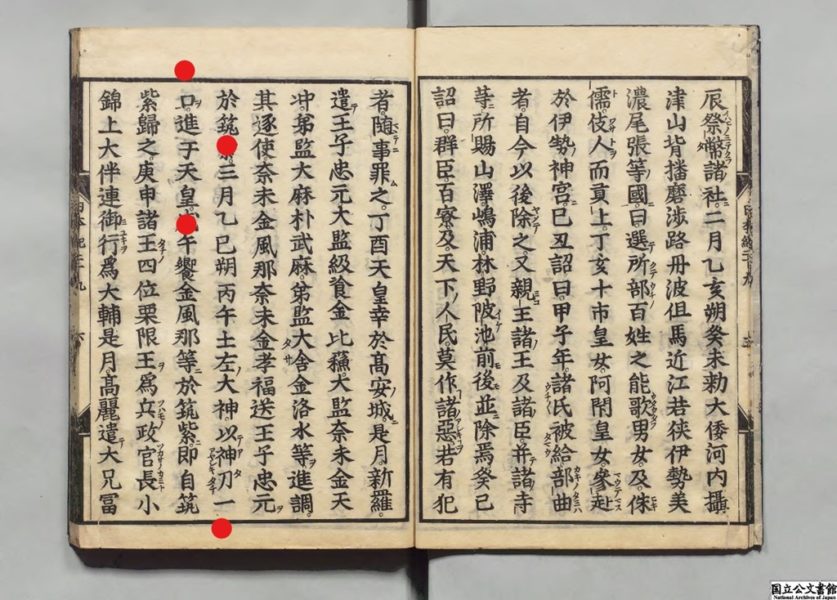
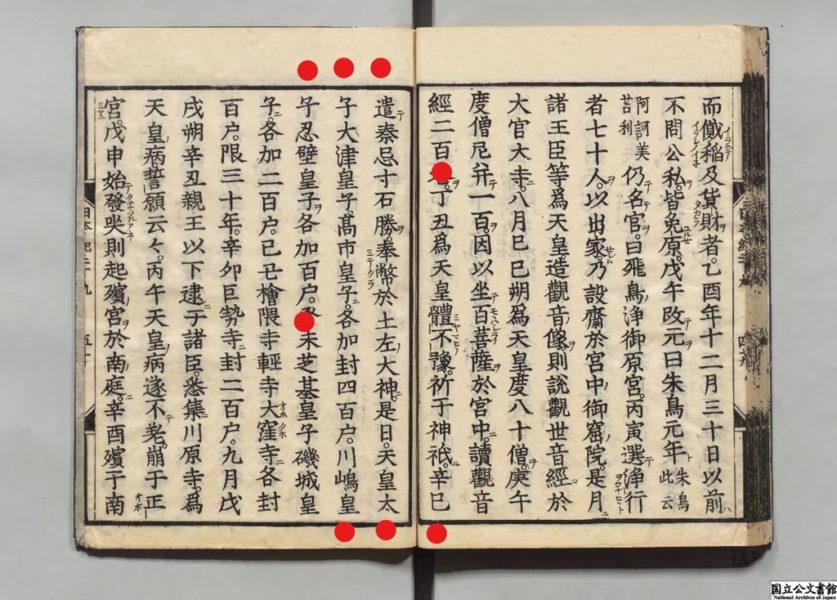
"Tsuku Nihongi" (764)
Translation
"Oten" who met Emperor Daihakuse "21st Emperor Yuyaku tenno" at Yamato Katsuragiyama competed for hunting with the Emperor.The Emperor got angry and was swept away by Tosa for that.
However, because he was an ancestral god of Mr. Kamo, it was enshrined in the 8th year of the Tenpei Hoji character, returning to the shrine of the main shrine in Katsukami-gun, Yamato Province."
[Reference] National Archives Digital Archive "Continued Nihonki" Enryaku 16 (797) Winner: Masamichi Sugano, Keicho
19 [Former Kuraya] Koyoyama Bunko https://www.digital.archives.go.jp/DAS/meta/listPhoto ?LANG=default&BID=F1000000000045548&ID=M2014100619504988793&TYPE=&NO=Image Utilization
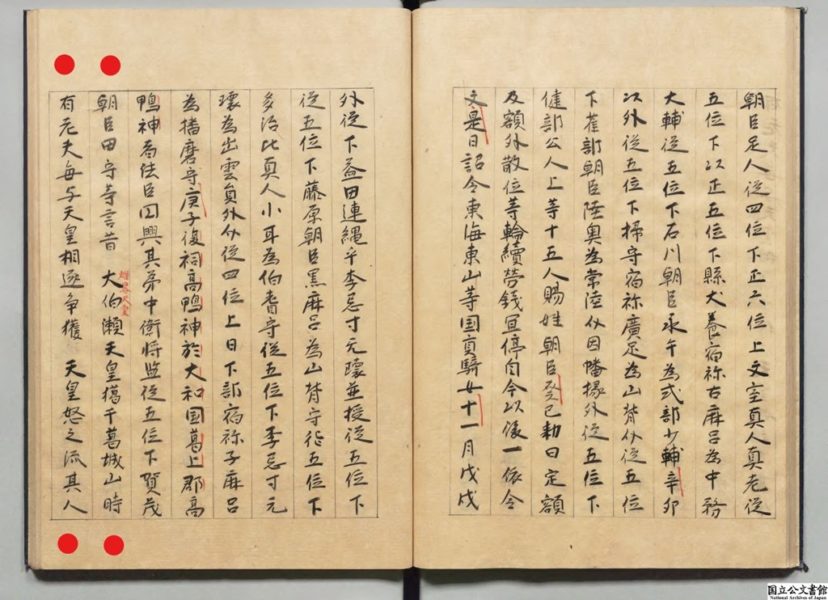
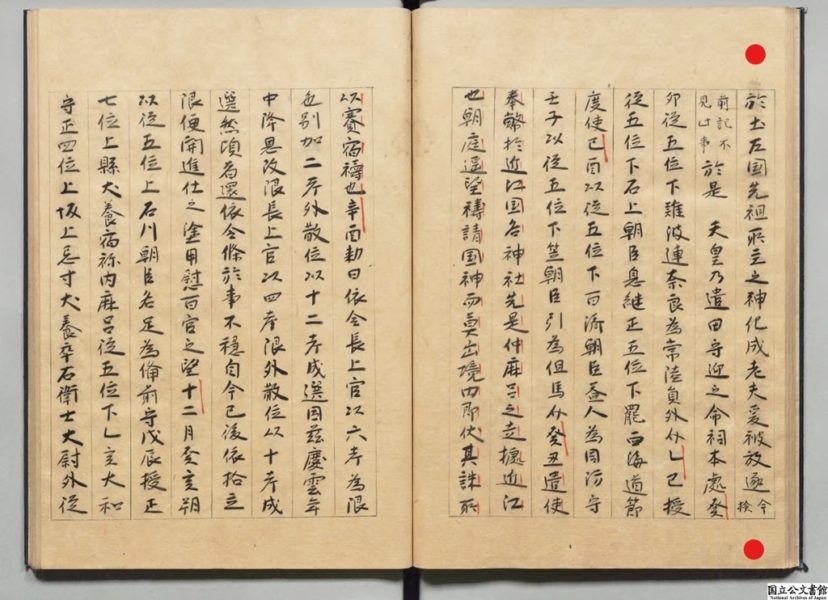
The Legend of "The God of The Festival" written in "Shaku Nihongi" Vol. 15 "Tosa Kuni Fudoki"
Translation
"Tosa no ohkomi presented a bite of god sword to the EmperorShinmei-gu Book: Tosa Kunitosa-gun Tosata Shrine (Large)
Tosa Kuni Fudoki
It is in the four villages to leave the west of the county family in the county of the county of the other side of the earth left.
The name of the god is "hitokotonushi no mikoto" of the taisha (Ohoyashiro) of The Left.
I don't know much about mioya.
According to aru tsutahe, the child of Ohoanamuchi no mikoto 鉏 Takahikone son (ajisuki takahikone no mikoto) Narito ifu"
[Reference] National Archives Digital Archives "Shaku Nihonki" Bunei Gennen (1264) - Masayasu 3rd year (1301) Manuscript (copy book) Meiji Author: Bokbe Kaiken
https://www.digital.archives.go.jp/DAS/meta/listPhoto?LANG=default&BID=F100000000045548 &ID=M2014100619504988793&TYPE=&NO=Image Use
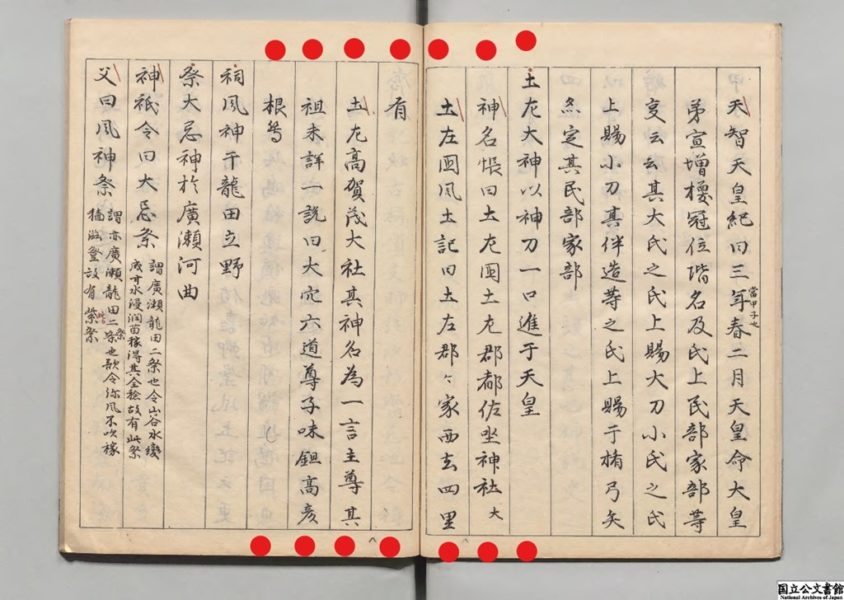
"Shaku Nihonki" Vol. 12 On the Tradition of the One Word Lord God Article
It is written about "one word main god" in "shakunki" which was established at the end of the Kamakura period.
Summary
"One thing, the Lord God
God's Name Book
Yamato Kunikatsujo-gun Katsuragiza One-place Main Shrine Meishin University Tsukiji Shinjo
Kojiki says...
Tosa Kuni Fudoki
It is in the four villages to leave the west of the county family in the county of the county of the other side of the earth left.
The name of the god is "hitokotonushi no mikoto" of the taisha (Ohoyashiro) of The Left.
I don't know much about mioya.
According to the aru tatsuhe, the child of Ohoanamuchi no mikoto,鉏 Ajisuki takahikona son (ajisuki takahikona no mikoto) Narito fuEmperor Yuroku (21st) February 4
When the Emperor was hunting at Yamato Katsuragiyama, the Emperor met a word lord god, and the word and behavior flowed a word master god to Tosa.The washed-out word god is enshrined in "Kamonochi" at first in Tosa, and is later transferred to "Tosa Takagamo Taisha" (present-day Tosa Shrine).
Then, in the 8th year of Tenpei Hoji (764), a word master god was transferred to "KatsuragiYama Higashi Shimomiyaokakami" in Yamato Province by Mr. Kamo's words.
However, the Japanese soul is still enshrined in Tosa province."
[Reference] National Archives Digital Archives "Shaku Nihonki" Bunei Gennen (1264) - Masayasu 3rd year (1301) Manuscript (copy book) Meiji Author: Bokbe Kaiken
https://www.digital.archives.go.jp/DAS/meta/listPhoto?LANG=default&BID=F100000000045548 &ID=M2014100619504988793&TYPE=&NO=Image Use
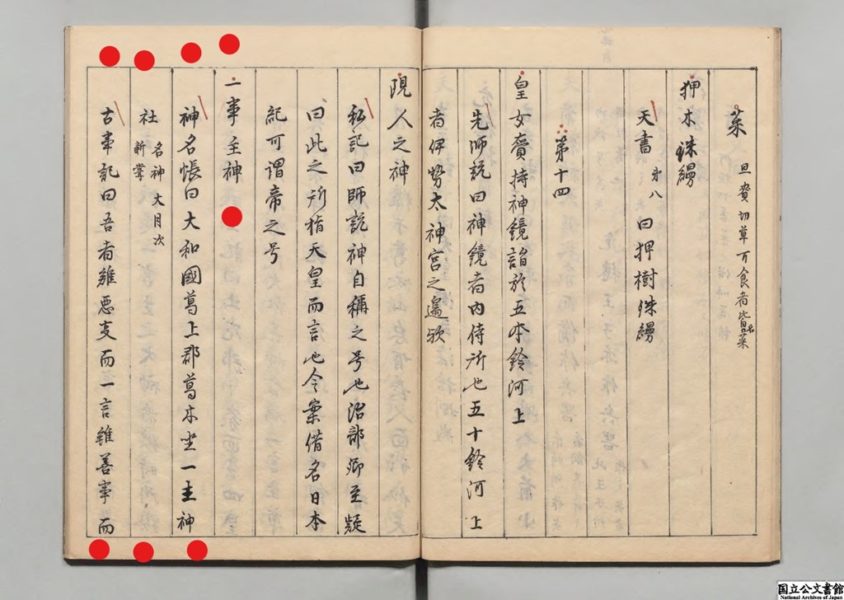
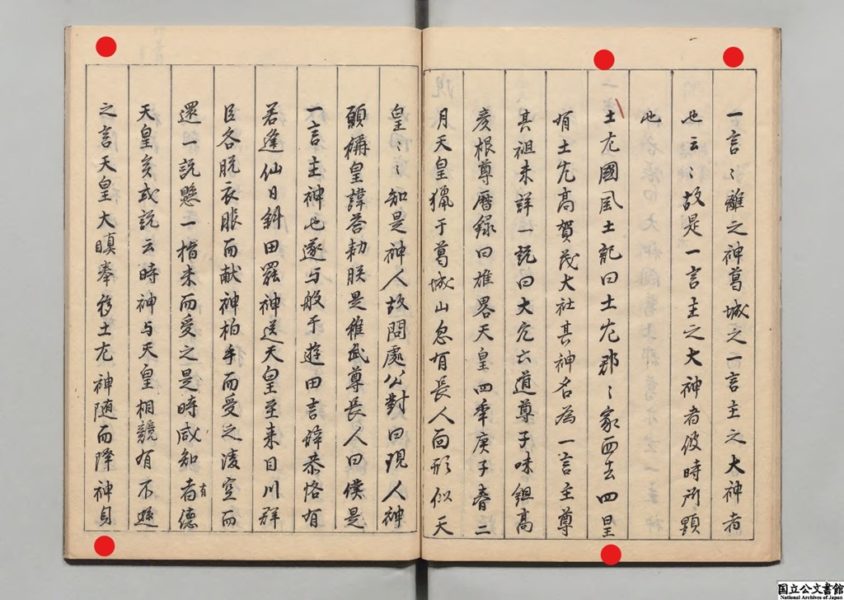
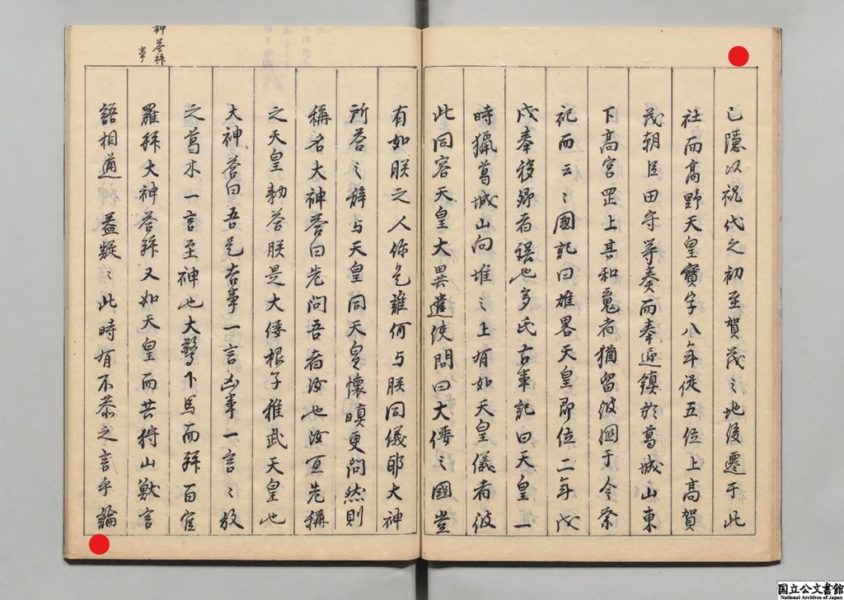
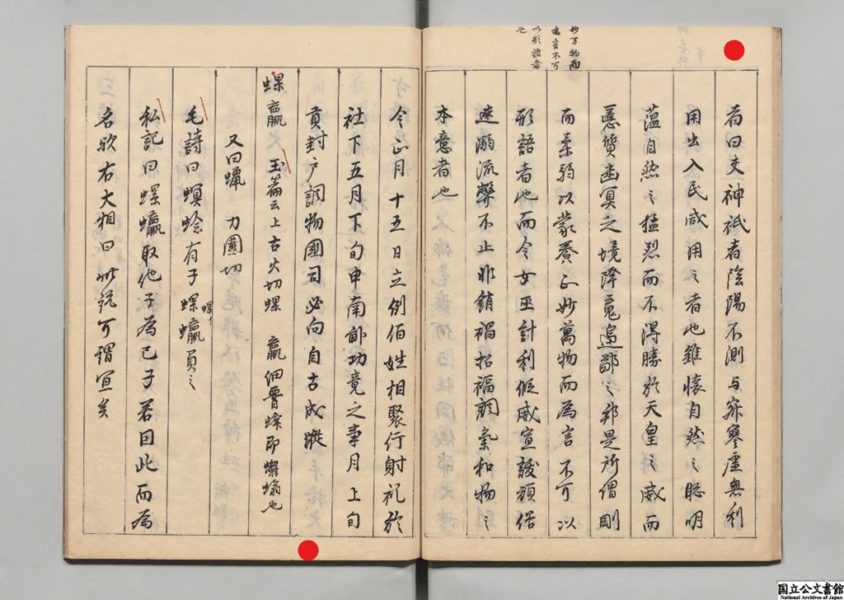
*Please see the story of "KatsuragiYama Higashi Shimomiya Okakami" in Yamato Province (present-day Katsuragi Ichigo-ushi Shrine).
Since ancient times, it has been dedicated to the natural stone "Iwakura" where God dwells, and it is said that the restoration of the restoration of the restoration to ancient times because this stone called "gravel isshi" fell to this place and stopped.
"hai" (90-degree bow) at Tosa Shrine (Tosa shrine)
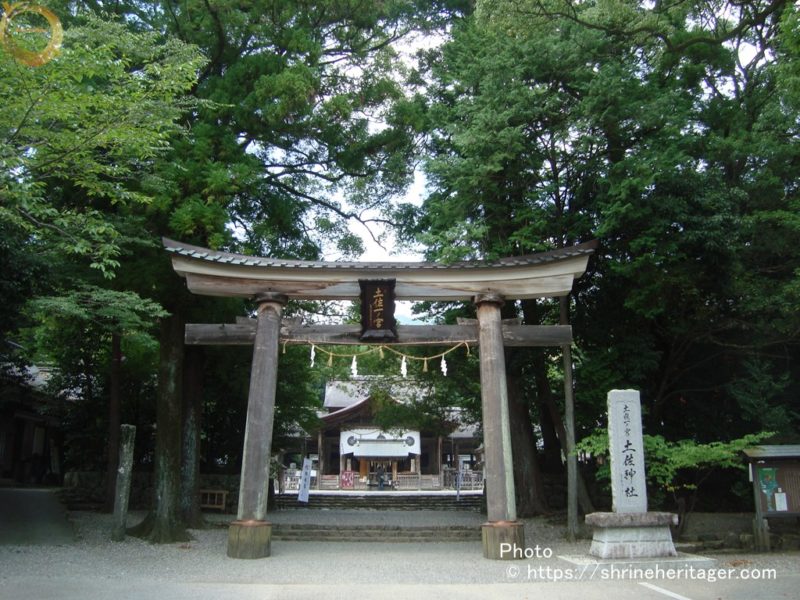
In the hi-designated area of "Kamonochi" where the god of Tosa Shrine was first enshrined
Kamo Shrine in the west (Irino and Shikinaisha, Kuroshio-cho, Hata-gun)
Kamo Shrine (Tanosato, Suzaki City)
There are various theories such as Naruno Shrine (Uranouchi, Suzaki City, Shikinaisha)

